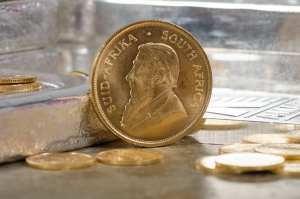Avid gold investors diversify their collections with a variety of proofs, non-numismatic, and foreign coins, but up until the 1980s, the international gold coin market was limited. The rise of gold coins in the latter 20th century was due to the popularity of the Krugerrand from South Africa, the world’s first legal tender gold bullion coin. Bullion coins are valued by their weight and purity rather than face-value, making them easy to trade with the current spot price.
How the Discovery of Gold Changed South Africa
South Africa is home to one of the largest gold deposits in the world, comprising a range of hills and valleys known as the “Golden Arc.”
The discovery of gold in the Witwatersrand area led to Africa’s gold rush in the late 19th century, and also to the Second Boer War, as colonists fought Britain over control of its natural resources. After the war drew to an end in 1902, the world’s largest gold refining and smelting complex, The Rand Refinery, was built just outside of Johannesburg.

Gold reserves allowed the new South African Republic to be financially independent at a time when the world’s banking system relied on gold. As the demise of the gold standard became imminent in the United States, South Africa produced around 70 percent of the world’s gold, and sought a new way to keep private ownership thriving.
The World's First Legal Gold Tender
They responded with the world’s first gold legal tender, the Krugerrand, introduced in 1967. Its name is a mashup paying homage to Paul Kruger, president of the Transvaal colony during the Second Boer War, and the ‘rand’ in Witwatersrand. As the Krugerrand could be bought and sold anywhere legally starting in 1967, it was mass-produced and quickly became the world’s most popular gold coin.
The Krugerrand has never had a face-value, deriving its value from the prevailing spot price of gold. Both non-numismatic and proofs circulate the market, giving the Krugerrand mass appeal to investors and collectors alike.
How the Krugerrand Has Evolved
The Krugerrand is 22 karat gold and is coated in a protective copper alloy, the coin still contains 1 Troy oz. of pure 24 karat gold. In 1980, South Africa introduced the fractional, or smaller Krugerrands in ½, ¼, 1/10 Troy oz. sizes.
With smaller tender available, the Krugerrand became an easy way to track the price of gold in the global market. In response to the popularity of the Krugerrand, bullion coins containing 1 oz. of pure gold were minted from several more countries, creating competition for the Krugerrand.

While the Krugerrand quickly became popular among global investors, the Nationalist Party that ruled South Africa since 1948 was fast-losing credibility due to its controversial laws known as apartheid. Western countries imposed increasing sanctions against South African imports and exports.
The Fall of the Krugerrand
In October 1985, the United States banned the importation of the Krugerrand coin in an effort to pressure South Africa to end apartheid. The ban lasted until apartheid ended with the collapse of the Nationalist Party in 1995, but not before the Krugerrand was forced to compete with the Canadian Maple Leaf, the Chinese Gold Panda, the British Britannia, and the American Eagle.
Still, the Krugerrand holds the world record as the highest circulating gold bullion coin, with over 50 million estimated to be in existence. It’s gained some publicity in America recently, as an anonymous donor has been dropping Krugerrands worth approximately $1,200-$1,500 in Salvation Army kettles over the past 20 years.
While the original bullion coin has been replaced in popularity by the American Eagle in recent years, it wasn’t until after tens of millions of Krugerrands were already in circulation. The model of the Krugerrand made gold ownership easy again, in an age where fiat currencies are by nature volatile, and coins were marked only by their numismatic value.
Posting in: